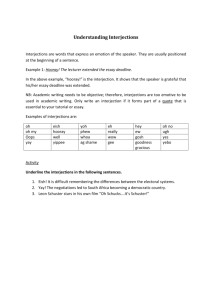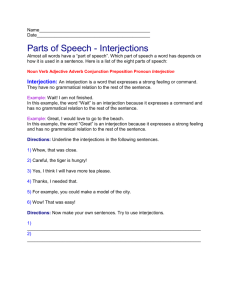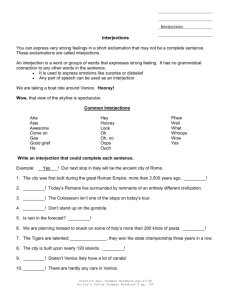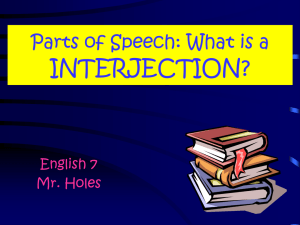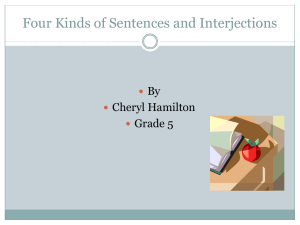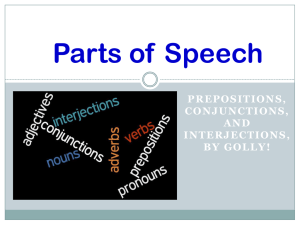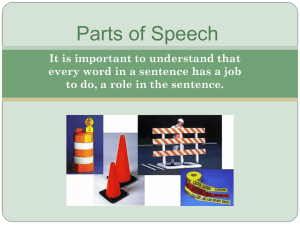Interjections in the EFL classroom: teaching sounds
advertisement
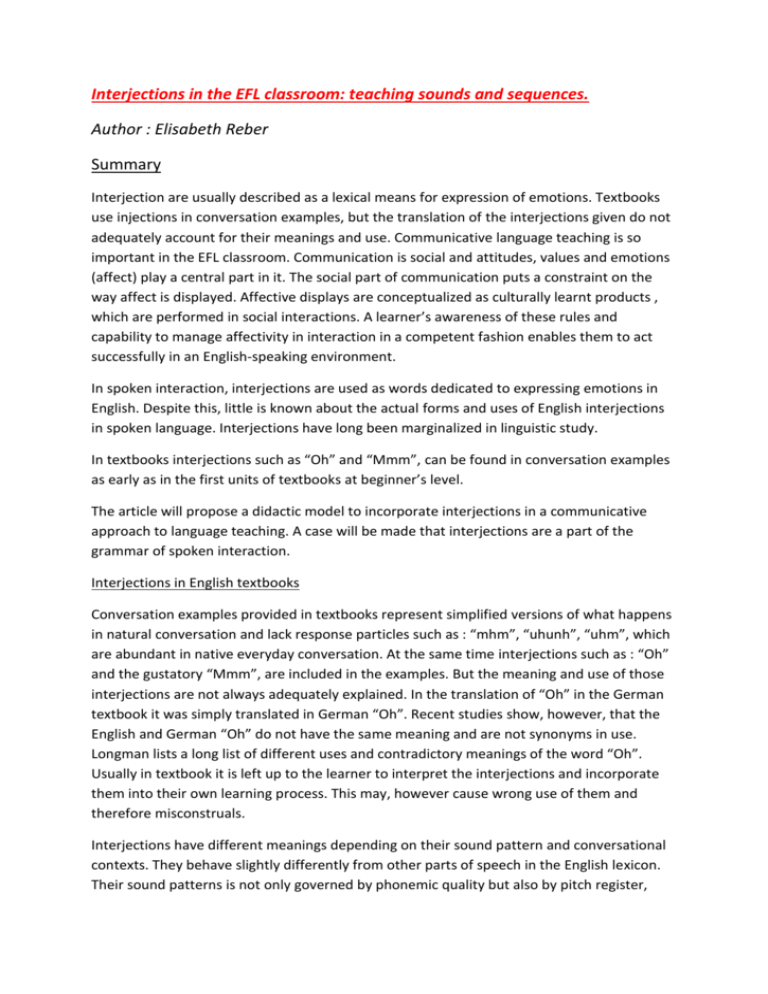
Interjections in the EFL classroom: teaching sounds and sequences. Author : Elisabeth Reber Summary Interjection are usually described as a lexical means for expression of emotions. Textbooks use injections in conversation examples, but the translation of the interjections given do not adequately account for their meanings and use. Communicative language teaching is so important in the EFL classroom. Communication is social and attitudes, values and emotions (affect) play a central part in it. The social part of communication puts a constraint on the way affect is displayed. Affective displays are conceptualized as culturally learnt products , which are performed in social interactions. A learner’s awareness of these rules and capability to manage affectivity in interaction in a competent fashion enables them to act successfully in an English-speaking environment. In spoken interaction, interjections are used as words dedicated to expressing emotions in English. Despite this, little is known about the actual forms and uses of English interjections in spoken language. Interjections have long been marginalized in linguistic study. In textbooks interjections such as “Oh” and “Mmm”, can be found in conversation examples as early as in the first units of textbooks at beginner’s level. The article will propose a didactic model to incorporate interjections in a communicative approach to language teaching. A case will be made that interjections are a part of the grammar of spoken interaction. Interjections in English textbooks Conversation examples provided in textbooks represent simplified versions of what happens in natural conversation and lack response particles such as : “mhm”, “uhunh”, “uhm”, which are abundant in native everyday conversation. At the same time interjections such as : “Oh” and the gustatory “Mmm”, are included in the examples. But the meaning and use of those interjections are not always adequately explained. In the translation of “Oh” in the German textbook it was simply translated in German “Oh”. Recent studies show, however, that the English and German “Oh” do not have the same meaning and are not synonyms in use. Longman lists a long list of different uses and contradictory meanings of the word “Oh”. Usually in textbook it is left up to the learner to interpret the interjections and incorporate them into their own learning process. This may, however cause wrong use of them and therefore misconstruals. Interjections have different meanings depending on their sound pattern and conversational contexts. They behave slightly differently from other parts of speech in the English lexicon. Their sound patterns is not only governed by phonemic quality but also by pitch register, pitch movement and duration. Being non-referential in meaning, their meaning is determined by the link between sound pattern and specific sequential context. In contrast to the words with strong referential meaning, the meaning of interjections is more implicit. Their competent use depends on the correct pronunciation and their timely positioning in a conversational sequence of actions. For this reason the following suggestions for teaching interjections are proposed : 1. Play sound examples of interjection from natural L1 speaker interaction. Play it repeatedly and have the students produce the object several times themselves. Play/ say interjections out of context first, so that they learn to appreciate vowel quality and prosody first (and then later put it in context). 2. Play an example from a natural L1 speaker interaction where the interaction is deployed. To illustrate conversational usage of the interjection, play an exemplary excerpt from a naturally occurring conversation where the interjection is actually deployed in the form and function to be taught. 3. Explain the sequential structure and usage of the interjection. The sequential patterning of social actions in the activity where the interjection is used. Point out what affect-laden responses may be expected in the social activity in question. 4. Discuss potential cross-cultural differences between native language and English variety. Although interjections are used in conversation examples in textbooks, their forms and conversational meanings are often poorly or not at all accounted for, if at all. Research in this perspective shows that the vocal, i.e. prosodic–phonetic, shape, and context-specific use of interjections contribute to their affective and discourse-organizational meanings. Given the current state of research, which does not yet provide a comprehensive catalogue of the sound patterns and context-specific uses of English interjections, the didactic suggestions offered for teaching can of course not be implemented for all interjections. However, to teach the sound patterns and usages of interjections on the basis of naturally occurring conversations rather than referring to invented conversation examples is the first step in abandoning stereotypical representations of the forms and functions of English interjections in everyday conversation and in appreciating the relevance of their vocal design and contextual factors in their meaning construction. Though not an easy task to master, in the long run, it will improve the learner’s competence of the conversational grammar of English and raise their awareness of the emotion rules at work in the linguistic community under examination. In this way, the teaching of the sounds and sequential contexts of interjections makes a valuable contribution to promoting the programme and goals of communicative language teaching.
